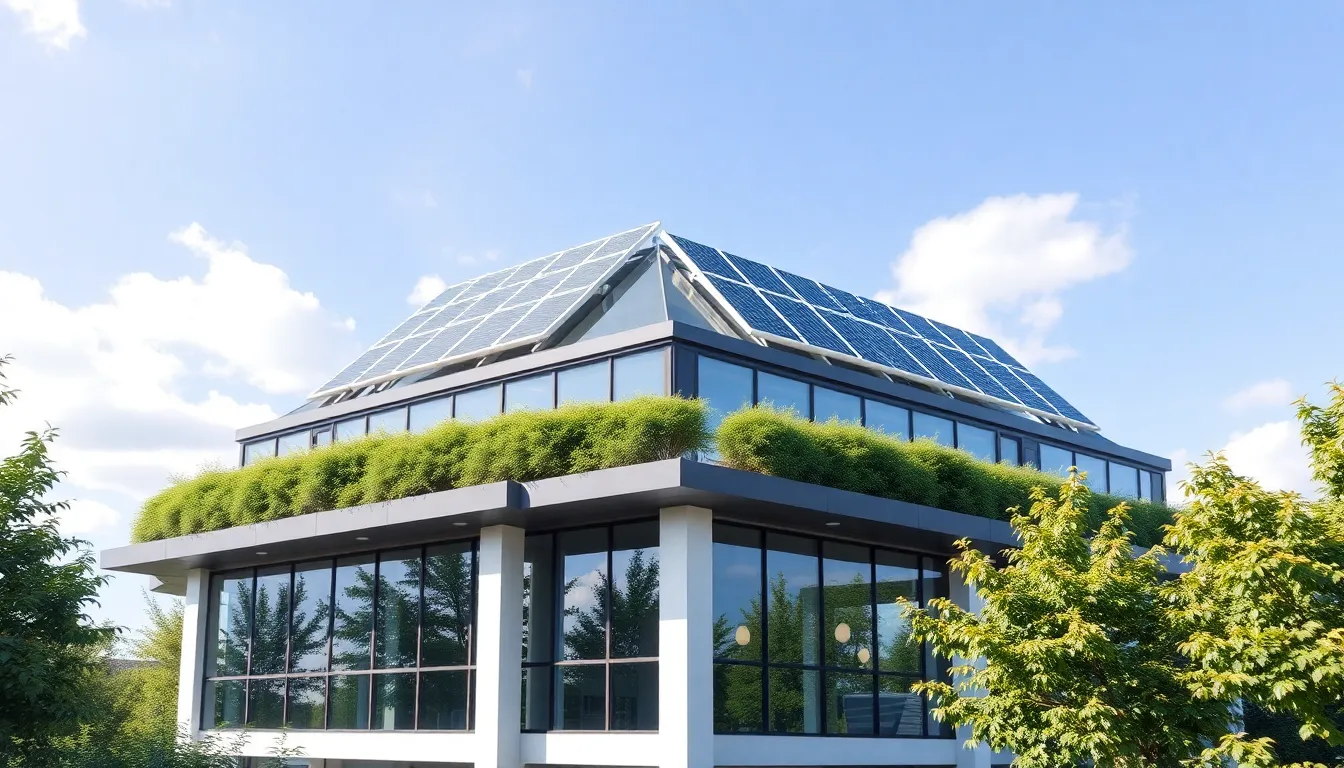Imagine walking into a building that knows you better than your best friend. The Internet of Things (IoT) is transforming ordinary structures into smart buildings that anticipate needs and streamline daily tasks. From adjusting the temperature to optimizing energy use, these intelligent systems are not just a luxury—they’re becoming the norm.
Table of Contents
ToggleOverview of Internet of Things for Smart Buildings
The Internet of Things (IoT) transforms buildings into smart environments capable of responding to occupant requirements. Smart buildings utilize interconnected systems, enabling continuous communication between devices and users. Automation features help in managing everyday functions such as climate control and energy consumption.
Enhanced comfort increases occupant satisfaction through adjustable lighting and temperature settings. Smart sensors monitor conditions in real time, ensuring optimal experiences in work and living spaces. Energy efficiency emerges as a primary benefit, resulting from data-driven strategies that minimize waste and reduce utility costs.
Security systems equipped with IoT technologies provide real-time surveillance and threat detection. Surveillance cameras, motion detectors, and alarm systems integrate seamlessly into a building’s overall infrastructure. Data gathered from these systems informs building managers, leading to swift responses to security breaches.
IoT applications extend into maintenance as well. Predictive maintenance techniques utilize analytics to forecast equipment failures before they occur, reducing overall downtime. Regular monitoring of HVAC systems and elevators ensures they operate efficiently, minimizing disruptive outages.
Smart buildings also contribute to sustainability efforts. Integrated sensors facilitate the collection of environmental data, helping organizations adhere to regulations and enhance green initiatives. By using renewable energy sources and optimizing energy consumption, smart buildings showcase a commitment to environmental responsibility.
Investment in IoT technologies presents long-term benefits for property owners and tenants alike. Enhanced operational efficiencies result in lowered costs and increased value for both commercial and residential spaces. As technology advances, the integration of IoT in buildings will play a critical role in future design and functionality.
Key Concepts and Technologies

The Internet of Things (IoT) for smart buildings relies on various concepts and technologies that make these structures responsive and efficient.
IoT Architecture for Smart Buildings
IoT architecture features a multi-layered design connecting various smart devices and systems. Devices at the edge layer collect data on environmental conditions, while a network layer facilitates communication between them. The data processing layer then analyzes this information to deliver actionable insights for decision-making. Integration capabilities allow for seamless interaction among lighting, heating, and security systems. This architecture ensures that buildings adapt automatically to the changing needs of occupants, improving overall comfort and efficiency.
Communication Protocols in IoT
Communication protocols play a critical role in enabling connectivity between devices in smart buildings. Protocols like MQTT and CoAP are lightweight and ideal for resource-constrained devices. Bluetooth and Zigbee also support short-range communication, helping devices exchange data efficiently. Wi-Fi provides broader connectivity, supporting higher bandwidth applications. Each protocol serves specific use cases, ensuring reliable data transmission and enhancing real-time monitoring capabilities across smart building environments.
Applications of IoT in Smart Buildings
IoT transforms buildings by enhancing energy efficiency, security, comfort, and sustainability. Various applications drive these advancements, making smart buildings more responsive to occupant needs.
Energy Management Systems
Energy management systems leverage IoT technologies to optimize consumption. Smart sensors monitor energy usage in real time, enabling equipment calibration according to actual demand. Such systems can reduce energy costs significantly, achieving savings of up to 30%. Automated controls can manage heating, cooling, and lighting based on occupancy patterns. These adjustments ensure efficiency and comfort for occupants while minimizing waste.
Security and Surveillance Solutions
Smart security solutions integrate IoT devices for superior safety measures. Sensors and cameras provide around-the-clock surveillance, enabling real-time monitoring of building perimeters. Advanced analytics can detect unusual behavior, triggering alerts for potential threats. Access control systems enhance security further by using biometric authentication or mobile credentials. Such technologies contribute to a more secure environment and provide peace of mind to occupants and building owners.
Smart Lighting and Climate Control
Smart lighting systems utilize IoT to create an adaptable environment. Sensors can adjust lighting based on the time of day or occupancy, optimizing both energy usage and occupant comfort. Climate control systems work similarly, leveraging data to maintain ideal temperature levels throughout a building. Integration of these systems leads to enhanced well-being and productivity for occupants, as an environment tailored to individual preferences fosters greater satisfaction.
Benefits of Implementing IoT in Smart Buildings
Smart buildings equipped with IoT technology provide numerous benefits that enhance operational efficiency and occupant quality of life. These advantages include cost savings, increased comfort, improved security, and sustainability.
Cost Savings and Efficiency
Cost savings emerge as a primary benefit of implementing IoT in smart buildings. Energy savings reach up to 30% through real-time monitoring and automation of consumption patterns. Systems designed for optimized energy use also reduce operational costs over time. Predictive maintenance capabilities facilitate timely repairs, minimizing downtime and preventing costly unexpected issues. Data-driven insights allow property managers to make informed decisions about resource allocation, further enhancing financial efficiency. Investment in IoT technology provides tangible returns, making it a smart choice for modern buildings.
Enhancing Occupant Comfort
Occupant comfort benefits significantly from IoT integration within smart buildings. Advanced systems enable personalized climate control, adjusting temperature and humidity according to individual preferences. Lighting can adapt automatically based on occupancy and time of day, creating a pleasant environment. Additionally, smart sensors monitor indoor air quality, ensuring a healthy living and working space. Responsive systems contribute to overall well-being, promoting productivity and satisfaction. Ultimately, a focus on comfort can lead to higher tenant retention and a positive experience for all occupants.
Challenges and Considerations
Implementing IoT in smart buildings presents various challenges and considerations that stakeholders must address.
Data Privacy and Security Concerns
Data privacy stands as a significant concern for smart buildings. Many devices collect sensitive information about occupants, raising questions about data integrity and protection. Security breaches can expose personal data or disrupt building operations. Compliance with regulations like GDPR is essential for maintaining trust. Organizations must implement robust cybersecurity measures and regularly update software to mitigate risks. Encryption protocols and secure communication channels play critical roles in safeguarding data. Furthermore, transparency about data usage with occupants enhances reassurance regarding privacy.
Integration with Existing Systems
Integrating new IoT technologies with existing systems poses challenges for facility managers. Compatibility issues may arise between legacy infrastructure and modern devices, requiring careful planning. Assessing current systems and identifying integration points is crucial for seamless operation. The complexity of diverse technologies can complicate the implementation process, impacting timelines and budgets. Training staff on new systems ensures efficient utilization. Selecting flexible solutions that scale with future technology developments fosters a smoother transition while maximizing investments.
The integration of IoT in smart buildings represents a significant leap toward enhancing operational efficiency and occupant satisfaction. With real-time monitoring and automated systems, buildings are becoming more responsive to the needs of their users. This shift not only leads to substantial cost savings but also fosters a healthier and more productive environment.
As property owners embrace these technologies, they position themselves at the forefront of sustainability and innovation. While challenges such as data privacy and system integration remain, the benefits of IoT far outweigh the hurdles. The future of smart buildings is bright, promising a seamless blend of comfort, security, and efficiency that will redefine the way spaces are experienced.





